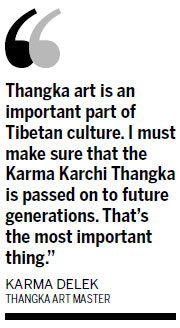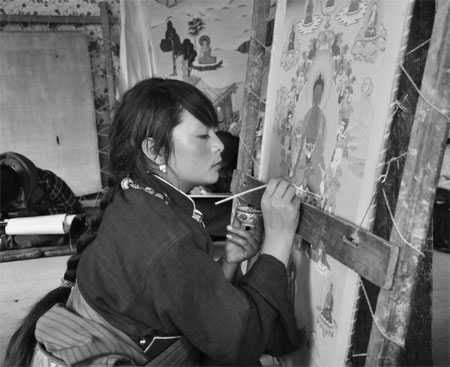Thangka art master passes on knowledge
For 82-year-old Thangka art master Karma Delek, nothing makes him happier than painting before his windows in his rural home in Karma town of Qamdo county in the Tibet autonomous region.
The town is known for its long tradition in making Thangka of the Karma Karchi style. For historical reasons, the Thangka art here was heavily influenced by the Han Chinese culture as well as others, making it distinct from other styles.
Karma Delek has been recognized as an outstanding member of the 10th generation successors of the Karma Karchi Thangka art. He still paints almost every day.
His family has been devoted to Thangka making for generations. His father was one of the best-known Thangka masters in his time. Under his influence, Karma Delek started learning Thangka painting when he was 8 years old.
As he recalled, learning Thangka took extremely hard work. Back then, he would paint from early morning to evening, and often continued painting by a butter-burning lamp when it got dark.
There weren't as many reference books back then, and every new learner must copy after the Measurement Scripture, a popular book introducing the art of Buddhist statues making, he recalled.
He studied with several Thangka masters of different styles besides his father. He became a well-known painter at only 16, when he received a special degree in Thangka painting.
Karma Delek was invited to Qinghai province to paint Thangka about a religious legend the same year. He vividly illustrated the legend with nine pieces, and was highly praised then by the religious head in Qinghai.
However, he had to give up Thangka painting during the "cultural revolution" (1966-76), and tried different occupations including teaching and becoming a veterinary sanitarian. As China started reform and opening-up in the 1980s, Karma Delek decided to go after his passion again.

Since then, he has also taken on the responsibility of passing on the art. He started recruiting apprentices from all over Tibet and has taught nearly 500 students for free.
As he recalled, many parents asked how much it would cost for their children to learn with a Thangka master like him, and he would answer that he doesn't charge at all, and even provides them with free food and accommodation.
"Thangka art is an important part of Tibetan culture," said Karma Delek. "I must make sure that the Karma Karchi Thangka is passed on to future generations. That's the most important thing,"
However, he has strict requirements for his students. According to him, both talent and hard work are important for Thangka study. The traditional learning method and a good teacher are also helpful.
"My students must really love the art and put inheriting the old craft before other concerns, such as improving their financial condition," he added.
His granddaughter, Detsing Yodron, is one of his current apprentices, whose age ranges from 7 to 20.
She is also among the dozens of female students Karma Delek taught in recent years. In the past, girls were not allowed to study Thangka, according to Detsing.
"I wish I can become a great painter like my grandfather," said Detsing, 18, who started learning Thangka at 15, adding that Karma Delek's meticulous and hard-working attitude had a deep influence on her.
Karma Delek explained that now it's more urgent to inherit than to innovate so as preserve the value of Karma Karchi Thangka art, which is closely associated with Tibetan culture and religion, and has absorbed the wisdom of many masters since the 16th century.
He is grateful that in recent years, the local government has carried out measures to protect local folk and ethnic arts including Karma Karchi Thangka. It was successfully listed as a national-level cultural heritage in 2008.
Earlier this year, 10 Thangka painters including Karma Delek, were promoted by the county's cultural department on two different exhibitions held in Lhasa and Beijing.
After the exhibitions, the China Thangka Culture Research Center in Beijing has booked over 364 pieces from Qamdo's Thangka painters, including 64 pieces from Karma Delek.
The total value is expected to reach 20 million yuan, and all the pieces will be collected as part of a permanent collection by the research center.
Celebrated as a national-level inheritor of Karma Karchi Thangka, Karma Delek has earned a series of titles and awards for his contribution to the art. However, he admitted that what made him most satisfied was the publishing of the book about Karma Karchi Thangka in 2009. It was completed with county government funding of 600,000 yuan.
Karma Delek spent three years drawing 110 statue design pictures for the book. Besides written introductions, the book has 65 examples of Karma Karchi Thangka pieces collected by monasteries or individuals, including some of Karma Delek's best works.
"It can be a textbook, and can also introduce Karmar Karchi Thangka to more people," he said.
liuxiangrui@chinadaily.com.cn
|
Karma Delek's granddaughter Detsing Yodron, 18, has become a Thankga painter. Liu Xiangrui / China Daily |



















